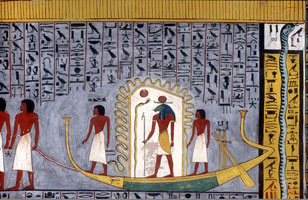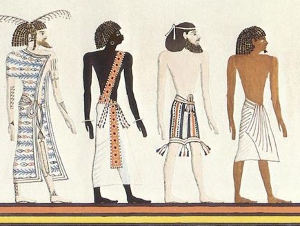The Book of Gates (sometimes also known as the “Book of Pylons”) is an ancient Egyptian religious text dating from the New Kingdom describing the journey of a deceased soul though the underworld with reference to the journey of the sun god (Ra) during the hours of the night.

The structure of the Book of Gates is similar to that of the Amduat. However, there are some notable differences; the last three hours contain depictions of the judgment of the dead; only Sia and Hu and Heka consistently travel with the sun god; four human beings tow the sun barque; instructions for the use of the book are replaced by instructions regarding offerings; and (most notably) each hour in the book of gates ends with a gate protected by one or more serpents and at least two guardians. In order to pass safely through each gate the deceased must name the guardians correctly. This tradition dates back to the Book of the Two Ways (part of the Coffin Texts), which recorded seven gates each with three guardians. Although other netherworld books refer to the existence of gates in the underworld, they are nowhere depicted in such detail as the Book of Gates.
In early versions of the Book of Gates the fifth hour depicts the judgement hall of Osiris. However, in the tomb of Seti I the deceased king stands before Osiris, and the emphasis moves from the judgement of the dead to the association between the deceased pharaoh and Osiris. His successors copied this innovation, with minimal changes to the position of the God in the scene. Most versions of the text also include extra texts which refer only to the king – ensuring the status of the deceased pharaoh.
Probably the most famous section of the Book of Gates is the text which describes the different races of people. The Egyptians divided all people into “Libyans”, “Nubians”, “Asiatics”, and “Egyptians”. All races were welcome in the afterworld and all are depicted journeying through its chambers.
Because of its similarity to the Amduat, Altenmuller suggested that it was composed some time before the New Kingdom. However, Hornung notes that the cosmopolitan spirit of the text does not fit with pre-Amarna attitudes and proposed that it was composed during the Amarna period (during the “Atenist Heresy” of Akhenaten). Yet, this too seems unlikely as the earliest version so far discovered is from the tomb of Horemheb who reigned immediately after the restoration of the traditional gods, and the text prominently features Osiris (particularly in the Hall of Judgement). That being said, the text was clearly influenced by the Atenist concept of a universal god.

Text and images from the Book of Gates appear in a number of New Kingdom tombs. Horemheb and Ramesses I had incomplete version in their sarcophagus chambers (replacing the usual passages from the Amduat). Seti I decorated his pillared halls with the Book of Gates, and had the first complete version inscribed on his sarcophagus, but also reinstated excerpts from the Amduat. Thereafter portions of the Book of Gates were inscribed in the upper pillared halls, sarcophagus chambers and subsidiary rooms of the pharaohs. Merenptah also included a complete copy on the walls of the cenotaph for Seti I at Abydos. Ramesses VI included a complete copy of the Book of Gates in his upper corridors, but chose to have the Book of the Earth in his sarcophagus chamber. However, Ramesses VII, only included the first two hours of the book and was the last pharaoh to include the Book of Gates in his tomb.
The Book of Gates also appeared in the tombs of a select few nobles and prominent officials, such as Sennedjem (a worker from Deir el-Medina, the workers village beside the Valley of the Kings) and Tjanefer (a priest of Amun). After the New Kingdom, sections of the book of Gates were occasionally merged with the Book of the Dead in the tombs of commoners and nobles. In particular, the first hour and the judgment hall remained in use in non-royal burials.
Not all of the texts are complete or in the correct order. The version in the tomb of Seti I has the hours in a continuous sequence ending with the last hour being placed by the head of the deceased king, but in other cases the hours are split up in different chambers. There were a total of one hundred scenes. Many of the early scenes are very large, but the last two hours contain a number of smaller scenes. The text is Middle Egyptian and displays little evidence of the influence of Late Egyptian, but does have a particularly wide and rich vocabulary.
Bibliography
- Dodson, Aiden (2016) The Royal Tombs of Ancient Egypt
- Hornung, Erik (1999) The Ancient Egyptian Books of the Afterlife
- Pinch, Geraldine (2002) Handbook Egyptian Mythology
- Redford Donald B (2002) Ancient Gods Speak
- Reeves, Nicholas and Wilkinson, Richard H. (1996) The Complete Valley of the Kings
- Strudwick, Nigel and Helen (1999) Thebes in Egypt
- Wilkinson, Richard H. and Weeks, Kent Editors (2016) The Oxford Handbook of the Valley of the Kings
Copyright J Hill 2010